初中英语语法八大时态总结完整版
- 格式:doc
- 大小:158.50 KB
- 文档页数:11
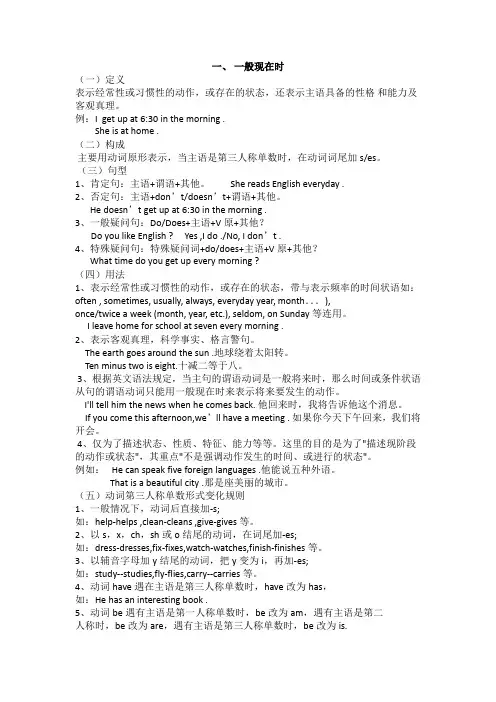
一、一般现在时(一)定义表示经常性或习惯性的动作,或存在的状态,还表示主语具备的性格和能力及客观真理。
例:I get up at6:30in the morning.She is at home.(二)构成主要用动词原形表示,当主语是第三人称单数时,在动词词尾加s/es。
(三)句型1、肯定句:主语+谓语+其他。
She reads English everyday.2、否定句:主语+don’t/doesn’t+谓语+其他。
He doesn’t get up at6:30in the morning.3、一般疑问句:Do/Does+主语+V原+其他?Do you like English?Yes,I do./No,I don’t.4、特殊疑问句:特殊疑问词+do/does+主语+V原+其他?What time do you get up every morning?(四)用法1、表示经常性或习惯性的动作,或存在的状态,带与表示频率的时间状语如:often,sometimes, usually, always, everyday year, month...),once/twice a week(month, year, etc.), seldom, on Sunday等连用。
I leave home for school at seven every morning.2、表示客观真理,科学事实、格言警句。
The earth goes around the sun.地球绕着太阳转。
Ten minus two is eight.十减二等于八。
3、根据英文语法规定,当主句的谓语动词是一般将来时,那么时间或条件状语从句的谓语动词只能用一般现在时来表示将来要发生的动作。
I'll tell him the news when he comes back.他回来时,我将告诉他这个消息。
If you come this afternoon,we’ll have a meeting.如果你今天下午回来,我们将开会。
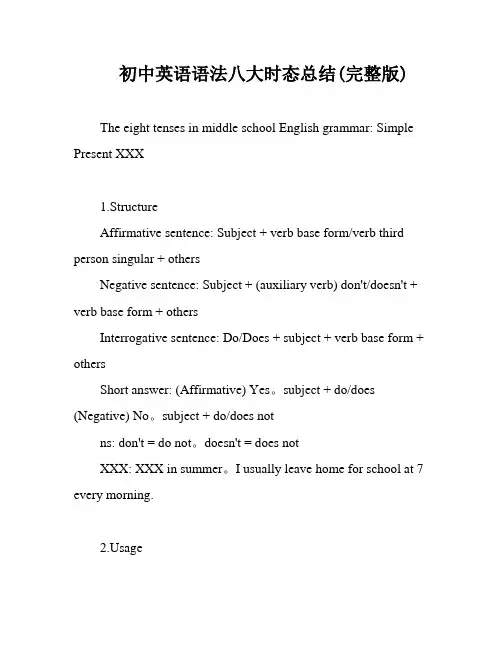
初中英语语法八大时态总结(完整版)The eight tenses in middle school English grammar: Simple Present XXX1.StructureAffirmative sentence: Subject + verb base form/verb third person singular + othersNegative sentence: Subject + (auxiliary verb) don't/doesn't + verb base form + othersInterrogative sentence: Do/Does + subject + verb base form + othersShort answer: (Affirmative) Yes。
subject + do/does (Negative) No。
subject + do/does notns: don't = do not。
doesn't = does notXXX: XXX in summer。
I usually leave home for school at 7 every morning.age1) It is used to express XXX existence。
often used with adverbs that indicate frequency。
Common frequency adverbs include: always。
often。
usually。
seldom。
never。
sometimes。
every week (day。
year。
month…)。
once a week。
on Sundays。
Frequency adverbs are usually placed before the n verb。
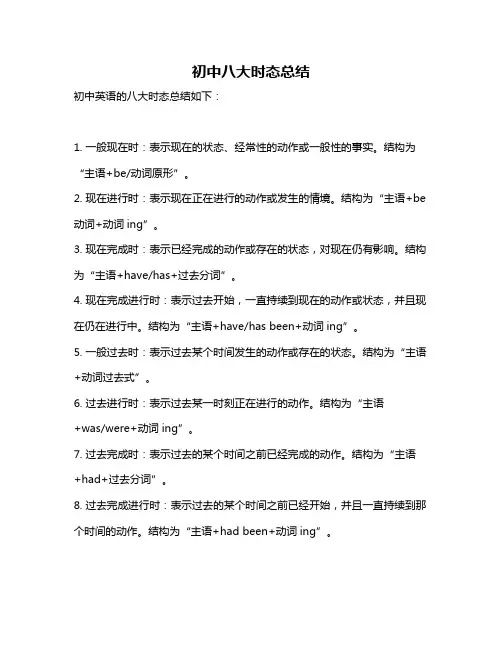
初中八大时态总结
初中英语的八大时态总结如下:
1. 一般现在时:表示现在的状态、经常性的动作或一般性的事实。
结构为“主语+be/动词原形”。
2. 现在进行时:表示现在正在进行的动作或发生的情境。
结构为“主语+be 动词+动词ing”。
3. 现在完成时:表示已经完成的动作或存在的状态,对现在仍有影响。
结构为“主语+have/has+过去分词”。
4. 现在完成进行时:表示过去开始,一直持续到现在的动作或状态,并且现在仍在进行中。
结构为“主语+have/has been+动词ing”。
5. 一般过去时:表示过去某个时间发生的动作或存在的状态。
结构为“主语+动词过去式”。
6. 过去进行时:表示过去某一时刻正在进行的动作。
结构为“主语
+was/were+动词ing”。
7. 过去完成时:表示过去的某个时间之前已经完成的动作。
结构为“主语+had+过去分词”。
8. 过去完成进行时:表示过去的某个时间之前已经开始,并且一直持续到那个时间的动作。
结构为“主语+had been+动词ing”。
以上是初中英语八大时态的总结,希望对你有所帮助。
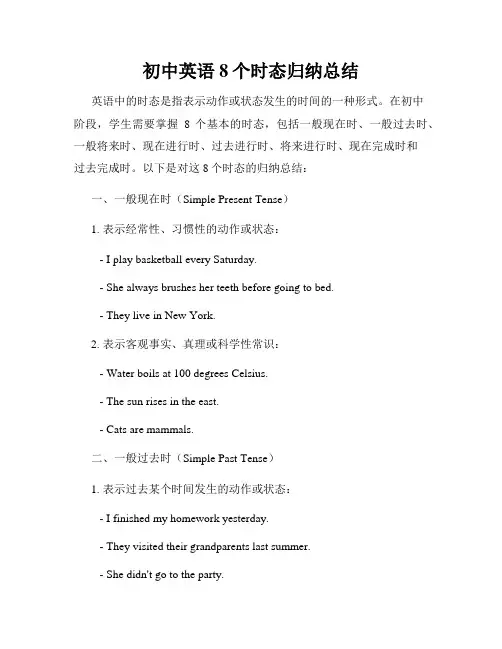
初中英语8个时态归纳总结英语中的时态是指表示动作或状态发生的时间的一种形式。
在初中阶段,学生需要掌握8个基本的时态,包括一般现在时、一般过去时、一般将来时、现在进行时、过去进行时、将来进行时、现在完成时和过去完成时。
以下是对这8个时态的归纳总结:一、一般现在时(Simple Present Tense)1. 表示经常性、习惯性的动作或状态:- I play basketball every Saturday.- She always brushes her teeth before going to bed.- They live in New York.2. 表示客观事实、真理或科学性常识:- Water boils at 100 degrees Celsius.- The sun rises in the east.- Cats are mammals.二、一般过去时(Simple Past Tense)1. 表示过去某个时间发生的动作或状态:- I finished my homework yesterday.- They visited their grandparents last summer.- She didn't go to the party.2. 表示过去的经历或习惯:- When I was young, I often went swimming. - He always ate breakfast at 8 o'clock.三、一般将来时(Simple Future Tense)1. 表示将来要发生的动作或事件:- I will go shopping tomorrow.- They are going to have a picnic next week. - She won't be late for the meeting.2. 表示将来的打算或意愿:- I am going to be a doctor when I grow up.- We will help you with your project.四、现在进行时(Present Continuous Tense)1. 表示现在正在进行的动作:- We are studying English at the moment.- He is playing soccer with his friends.- They aren't watching TV right now.2. 表示现阶段的趋势或变化:- The population is increasing rapidly.- More and more people are using smartphones.五、过去进行时(Past Continuous Tense)1. 表示过去某一时间段内正在进行的动作:- I was reading a book when the phone rang.- They were cooking dinner at 7 o'clock.2. 表示过去的同时发生的两个动作:- She was listening to music while doing her homework.六、将来进行时(Future Continuous Tense)1. 表示将来某一时间段内正在进行的动作:- Tomorrow, they will be flying to Paris.- I will be waiting for you at the station.2. 表示将来的预测或计划:- This time next month, I will be studying for my exams.七、现在完成时(Present Perfect Tense)1. 表示过去某一时间发生的动作对现在造成的影响或结果: - I have finished my homework, so I can watch TV now.- She has already eaten lunch.2. 表示过去某一时间内多次发生的动作:- We have visited that museum several times.八、过去完成时(Past Perfect Tense)1. 表示过去某一时间点之前已经完成的动作:- By the time they arrived, we had already left.- I had finished my work before the deadline.2. 表示过去的顺序或先后关系:- She realized that she had forgotten her keys after she locked the door.以上是初中英语的8个时态的归纳总结。
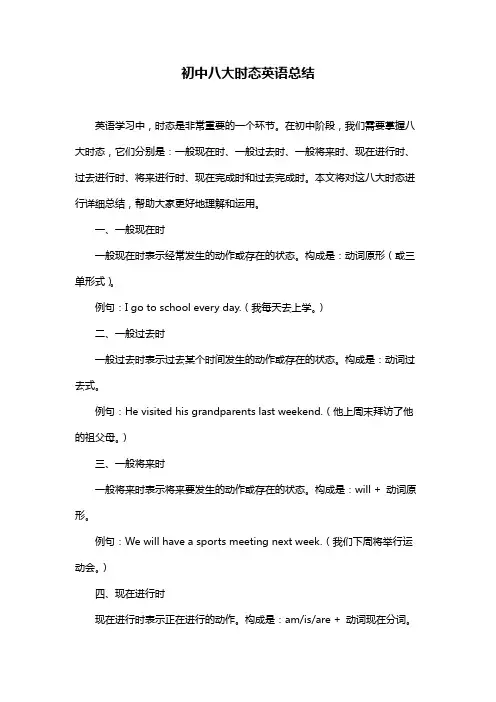
初中八大时态英语总结英语学习中,时态是非常重要的一个环节。
在初中阶段,我们需要掌握八大时态,它们分别是:一般现在时、一般过去时、一般将来时、现在进行时、过去进行时、将来进行时、现在完成时和过去完成时。
本文将对这八大时态进行详细总结,帮助大家更好地理解和运用。
一、一般现在时一般现在时表示经常发生的动作或存在的状态。
构成是:动词原形(或三单形式)。
例句:I go to school every day.(我每天去上学。
)二、一般过去时一般过去时表示过去某个时间发生的动作或存在的状态。
构成是:动词过去式。
例句:He visited his grandparents last weekend.(他上周末拜访了他的祖父母。
)三、一般将来时一般将来时表示将来要发生的动作或存在的状态。
构成是:will + 动词原形。
例句:We will have a sports meeting next week.(我们下周将举行运动会。
)四、现在进行时现在进行时表示正在进行的动作。
构成是:am/is/are + 动词现在分词。
例句:She is watching TV now.(她现在正在看电视。
)五、过去进行时过去进行时表示过去某个时间正在进行的动作。
构成是:was/were + 动词现在分词。
例句:They were playing football at 4 p.m.yesterday.(昨天下午4点他们正在踢足球。
)六、将来进行时将来进行时表示将来某个时间正在进行的动作。
构成是:will be + 动词现在分词。
例句:We will be having a meeting at that time tomorrow.(明天那个时候我们将在开会。
)七、现在完成时现在完成时表示过去发生的动作对现在造成的影响或结果。
构成是:have/has + 动词过去分词。
例句:I have finished my homework.(我已经完成了我的家庭作业。
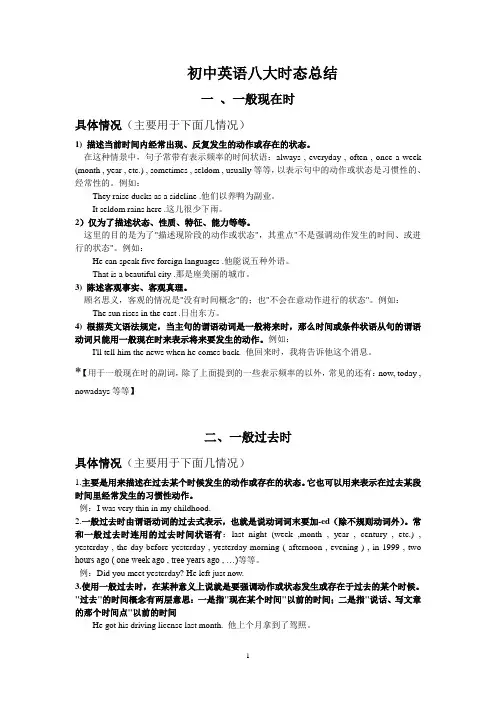
初中英语八大时态总结一、一般现在时具体情况(主要用于下面几情况)1) 描述当前时间内经常出现、反复发生的动作或存在的状态。
在这种情景中,句子常带有表示频率的时间状语:always , everyday , often , once a week (month , year , etc.) , sometimes , seldom , usually等等,以表示句中的动作或状态是习惯性的、经常性的。
例如:They raise ducks as a sideline .他们以养鸭为副业。
It seldom rains here .这儿很少下雨。
2)仅为了描述状态、性质、特征、能力等等。
这里的目的是为了"描述现阶段的动作或状态",其重点"不是强调动作发生的时间、或进行的状态"。
例如:He can speak five foreign languages .他能说五种外语。
That is a beautiful city .那是座美丽的城市。
3) 陈述客观事实、客观真理。
顾名思义,客观的情况是"没有时间概念"的;也"不会在意动作进行的状态"。
例如:The sun rises in the east .日出东方。
4) 根据英文语法规定,当主句的谓语动词是一般将来时,那么时间或条件状语从句的谓语动词只能用一般现在时来表示将来要发生的动作。
例如:I'll tell him the news when he comes back. 他回来时,我将告诉他这个消息。
*【用于一般现在时的副词,除了上面提到的一些表示频率的以外,常见的还有:now, today , nowadays等等】二、一般过去时具体情况(主要用于下面几情况)1.主要是用来描述在过去某个时候发生的动作或存在的状态。
它也可以用来表示在过去某段时间里经常发生的习惯性动作。
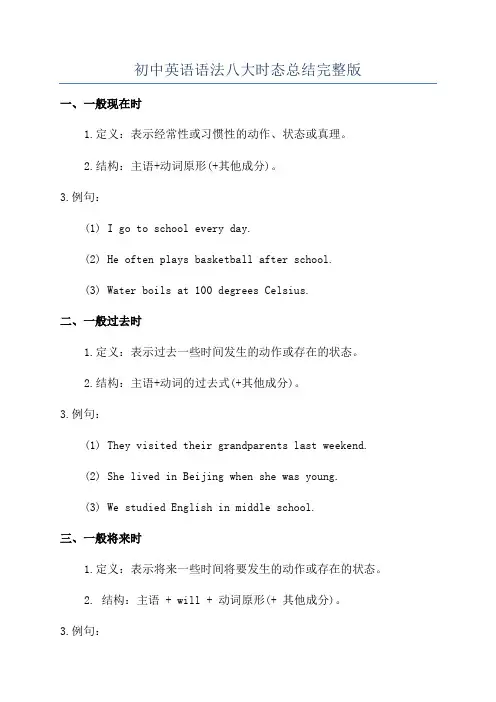
初中英语语法八大时态总结完整版一、一般现在时1.定义:表示经常性或习惯性的动作、状态或真理。
2.结构:主语+动词原形(+其他成分)。
3.例句:(1) I go to school every day.(2) He often plays basketball after school.(3) Water boils at 100 degrees Celsius.二、一般过去时1.定义:表示过去一些时间发生的动作或存在的状态。
2.结构:主语+动词的过去式(+其他成分)。
3.例句:(1) They visited their grandparents last weekend.(2) She lived in Beijing when she was young.(3) We studied English in middle school.三、一般将来时1.定义:表示将来一些时间将要发生的动作或存在的状态。
2. 结构:主语 + will + 动词原形(+ 其他成分)。
3.例句:(1) I will go to the park tomorrow.(3) We will have a party next week.四、现在进行时1.定义:表示现在正在进行的动作。
2. 结构:主语 + am/is/are + 动词-ing(+ 其他成分)。
3.例句:(1) She is reading a book right now.(2) They are playing soccer in the park.(3) We are having dinner at the moment.五、过去进行时1.定义:表示过去一些时间正在进行的动作。
2. 结构:主语 + was/were + 动词-ing(+ 其他成分)。
3.例句:(1) He was watching TV at 8 o'clock last night.(2) They were traveling in Europe during summer vacation.(3) We were studying when the phone rang.六、将来进行时1.定义:表示将来一些时间正在进行的动作。
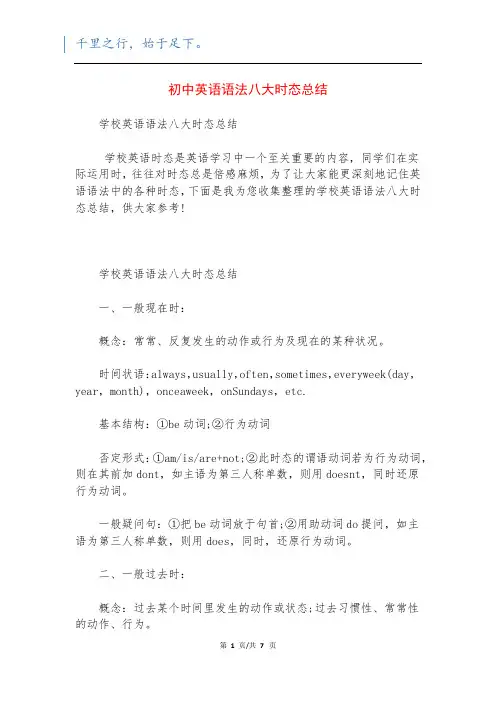
初中英语语法八大时态总结学校英语语法八大时态总结学校英语时态是英语学习中一个至关重要的内容,同学们在实际运用时,往往对时态总是倍感麻烦,为了让大家能更深刻地记住英语语法中的各种时态,下面是我为您收集整理的学校英语语法八大时态总结,供大家参考!学校英语语法八大时态总结一、一般现在时:概念:常常、反复发生的动作或行为及现在的某种状况。
时间状语:always,usually,often,sometimes,everyweek(day,year,month),onceaweek,onSundays,etc.基本结构:①be动词;②行为动词否定形式:①am/is/are+not;②此时态的谓语动词若为行为动词,则在其前加dont,如主语为第三人称单数,则用doesnt,同时还原行为动词。
一般疑问句:①把be动词放于句首;②用助动词do提问,如主语为第三人称单数,则用does,同时,还原行为动词。
二、一般过去时:概念:过去某个时间里发生的动作或状态;过去习惯性、常常性的动作、行为。
时间状语:ago,yesterday,thedaybeforeyesterday,lastweek(year,night,month),in1989,justnow,attheageof5,oneday,longlongago,onceuponatime,etc.基本结构:①be动词;②行为动词否定形式:①was/were+not;②在行为动词前加didnt,同时还原行为动词。
一般疑问句:①was或were放于句首;②用助动词do的过去式did提问,同时还原行为动词。
三、现在进行时:概念:表示现阶段或说话时正在进行的动作及行为。
时间状语:now,atthistime,thesedays,etc.基本结构:am/is/are+doing否定形式:am/is/are+not+doing.一般疑问句:把be动词放于句首。
四、过去进行时:概念:表示过去某段时间或某一时刻正在发生或进行的行为或动作。
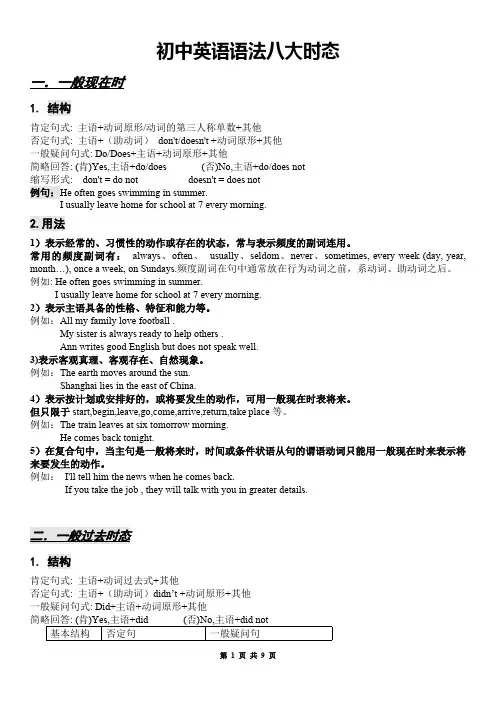
初中英语语法八大时态一.一般现在时1. 结构肯定句式: 主语+动词原形/动词的第三人称单数+其他否定句式: 主语+(助动词)don't/doesn't +动词原形+其他一般疑问句式: Do/Does+主语+动词原形+其他简略回答: (肯)Yes,主语+do/does (否)No,主语+do/does not缩写形式: don't = do not doesn't = does not例句:He often goes swimming in summer.I usually leave home for school at 7 every morning.2.用法1)表示经常的、习惯性的动作或存在的状态,常与表示频度的副词连用。
常用的频度副词有:always、often、usually、seldom、never、sometimes, every week (day, year, month…), once a week, on Sundays.频度副词在句中通常放在行为动词之前,系动词、助动词之后。
例如: He often goes swimming in summer.I usually leave home for school at 7 every morning.2)表示主语具备的性格、特征和能力等。
例如:All my family love football .My sister is always ready to help others .Ann writes good English but does not speak well.3)表示客观真理、客观存在、自然现象。
例如:The earth moves around the sun. Shanghai lies in the east of China.4)表示按计划或安排好的,或将要发生的动作,可用一般现在时表将来。
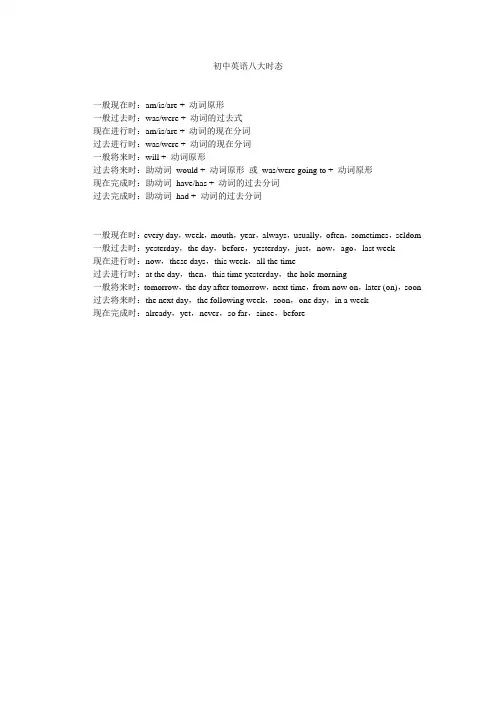
初中英语八大时态
一般现在时:am/is/are + 动词原形
一般过去时:was/were + 动词的过去式
现在进行时:am/is/are + 动词的现在分词
过去进行时:was/were + 动词的现在分词
一般将来时:will + 动词原形
过去将来时:助动词would + 动词原形或was/were going to + 动词原形
现在完成时:助动词have/has + 动词的过去分词
过去完成时:助动词had + 动词的过去分词
一般现在时:every day,week,mouth,year,always,usually,often,sometimes,seldom 一般过去时:yesterday,the day,before,yesterday,just,now,ago,last week
现在进行时:now,these days,this week,all the time
过去进行时:at the day,then,this time yesterday,the hole morning
一般将来时:tomorrow,the day after tomorrow,next time,from now on,later (on),soon 过去将来时:the next day,the following week,soon,one day,in a week
现在完成时:already,yet,never,so far,since,before。

初中英语语法八大时态总结一、一般现在时态(Simple Present)1.表示现在经常性、习惯性的动作或状态:- Lucy goes to school by bus every day.- They often play basketball in the park.2.表示客观事实或普遍真理:- The sun rises in the east.- Water boils at 100 degrees Celsius.3.表示评论、观点等:- I think it's a good idea.- He doesn't like swimming.二、一般过去时态(Simple Past)1.表示过去一些时间发生的动作或状态:- They visited their grandparents last weekend.- I lived in London for two years.2.表示过去的经常性动作或状态:- We often played soccer after school.- She worked in a restaurant when she was a student.3.表示与现在相反的情况或假设:- If I had money, I would buy a new car.- I wish I could go to the concert with you.三、一般将来时态(Simple Future)1.表示将来要发生的事情:- I will meet him at the airport tomorrow.- They are going to have a party next week.2.表示意愿、打算或承诺:- I promise I will help you.- She is going to study abroad next year.四、现在进行时态(Present Continuous)1.表示现在正在进行或暂时的动作:- They are playing football in the park.- He is studying for the exam.2.表示现阶段的变化或趋势:- The population of the city is increasing rapidly.- More and more people are using smartphones.五、过去进行时态(Past Continuous)1.表示过去一些时间正在进行中的动作:- I was watching TV when she called me.- They were having dinner when the power went out.2.表示过去一些时间同时发生的两个动作:- While he was reading, his sister was playing the piano.- When I arrived, they were still waiting for you.六、将来进行时态(Future Continuous)1.表示将来一些时间正在进行的动作:- He will be sleeping when you arrive.2.表示将来一些时间同时发生的两个动作:- While you are washing the dishes, I will be cleaning the bathroom.- When I call you, she will be cooking dinner.七、现在完成时态(Present Perfect)1.表示过去发生但对现在有影响的动作或状态:- I have lost my key, so I can't open the door.- She has finished her homework, so she can watch TV now.2.表示经历或遭遇过的事情:- Have you ever been to Paris?- He has never seen such a beautiful sunset.八、过去完成时态(Past Perfect)1.表示在过去一些时间之前已经发生的动作或状态:- When I arrived, they had already left.2.表示过去一些时间之前一直存在或保持的状态:- He had lived in that house for 10 years before he moved out.- She had been planning the party for weeks.。
初中英语基本时态总结Ⅰ、一般现在时1、概念:1)表示经常性或习惯性的动作,常与表示频度的时间状语连用。
时间状语:always, usually, often, sometimes, seldom, never, every day, twice a week, on Sunday, etc.(提问用How often)例:I leave home for school at 7 every morning.Tom gets up at 6:00 every morning.2)客观真理,客观存在,科学事实。
例:The earth moves around the sun. 地球绕太阳转动。
Shanghai lies in the east of China. 上海位于中国东部。
3)格言或警句。
例:Pride goes before a fall. 骄者必败。
注意:宾语从句中,即使主句是过去时,从句谓语是客观真理也要用一般现在时。
例:Columbus proved that the earth is round. 哥伦布证实了地球是圆的。
2、结构:表状态S+ am/is/are+ P (句中有实义动词不用be)表动作S+V原+O (若主语是单三人称,谓动加s/es。
)3、句式变化:变疑问,有be把be提到主语前;无be在主语前加do/does,谓动变为原形。
变否定,有be在be后加“not”;无be在主语后加don’t/doesn’t,谓动变为原形。
例:①They are in the classroom. →Are they in the classroom? Yes, they are./No, they aren’t. →They aren’t in the classroom②He often waters the flowers . → Does he often water the flowers?Yes, he does. / No, he doesn’t. →He doesn’t often water the flowersⅡ、一般过去时1、概念:1)表示在确定的过去时间里所发生的动作或存在的状态。
展宏学校中考英语常考八大时态与被动语态类别一般现在时现在进行时现在完成时一般将来时用途谓语结构(动词形式 ) 被动结构时态标志1.表示经常性、习惯性的动作;表示现在(说话瞬间)正2.表示客观事实或永恒真理;在进行或发生的动作。
3.表示特征、爱好、状态和能力等。
V.原或 V.三单 (he/she/it 或能够用he/she/it 代替的人或物后用三单 )am / is / are + 过分am / is / are +being+过分1. 频率副词: often;sometimes=(at 1. now = at present = righttimes); always; usually; every day now = at the moment(every + 时间 ) 2. look, listen开头的句2. 次数: twice a week子。
3. on Sundays:在每一个星期天例句 :例句 :She is watering the treesHe often cleans the room. 主(动 )now. (主动 )The roomoften by him.The trees by(被动 )her now. (被动 )1. 表示发生在过去的动表示将来某个时间要发生的作一直持续到现在; 2.动作或存在的状态。
表示发生在过去的动作对现在造成的影响或结果。
have/has + 过分 1.will + V .原2.be going to + V.原have / has been + 过分will be + 过分1. for / since+时间; 1.将来的时间: tomorrow;the day2. 副词 ever, never, yet,after tomorrow;next week ;in a fewalready 等;days;in 3 years;in the future ;this3. so far = by now=up to evening/year/weeknow; 2. at once=in a minute=right away3.soon4.in the last/past few 例句 :years;She will do it tomorrow. ( 主动 )It by her5.over the years= in tomorrow. (被动 )recent years在主从复合句中,当主句为一般将来It ’s 7 o’clock + 现在进行时、主句为祈使句、主句含有情态动时。
初中英语八种时态归纳
初中英语八种时态包括:一般现在时、一般过去时、现在进行时、过去进行时、现在完成时、过去完成时、一般将来时和过去将来时。
1. 一般现在时:表示通常性、规律性、习惯性的状态或者动作(有时间规律发生的时间状语)。
动词用原形。
2. 一般过去时:表示过去某个时间里发生的动作或状态;或过去习惯性的动作。
动词过去式发生变化。
3. 现在进行时:表示现在进行的动作或存在的状态。
现在进行时的基本结构:主语+系动词+表语+其他。
4. 过去进行时:表示过去某段时间或某一时刻正在发生或进行的动作。
其结构由连接词was/were+动词的现在分词构成。
5. 现在完成时:表示过去发生的动作对现在造成的影响或结果。
动词结构是“have+过去分词”。
6. 过去完成时:表示在过去某一时间或动作之前已经发生或完成的动作。
动词结构是“had+过去分词”。
7. 一般将来时:表示将来发生的动作或存在的状态,也表示将来要实行的计划或打算。
动词结构是“will+动词原形”或“be going to+动词原形”。
8. 过去将来时:表示在过去某个时间看来将要发生的动作或存在的状态,及过去的打算或推测。
动词结构是“would+动词原形”或“was/were going to+动词原形”。
以上是初中英语八种时态的归纳,记住口诀“4个1,24678”,即每一种时态都有一种标志性的结构,如一般现在时的标志性结构是主语+系动词+表语,一般过去时的标志性结构是主语+动词的过去式等。
(一)一般现在时1. 概念:经常、反复发生的动作或行为及现在的某种状况。
2. 基本结构:①is/am/are;②do/does否定形式:①am/is/are+not;②此时态的谓语动词若为行为动词,则在其前加don't,如主语为第三人称单数,则用doesn't,同时还原行为动词。
3. 一般疑问句:①把is/am/are动词放于句首;②用助动词do提问,如主语为第三人称单数,则用does,同时,还原行为动词。
4. 用法1) 经常性或习惯性的动作,常与表示频度的时间状语连用。
例如:I leave home for school at 7 every morning. 每天早上我七点离开家。
2) 客观真理,客观存在,科学事实。
例如:The earth moves around the sun. 地球绕太阳转动。
Shanghai lies in the east of China. 上海位于中国东部。
3) 表示格言或警句。
例如:Pride goes before a fall. 骄者必败。
注意:此用法如果出现在宾语从句中,即使主句是过去时,从句谓语也要用一般现在时。
例如:Columbus proved that the earth is round. 哥伦布证实了地球是圆的。
4) 现在时刻的状态、能力、性格、个性。
例如:I don't want so much. 我不要那么多。
Ann writes good English but does not speak well.安英语写得不错,讲的可不行。
5) 一般现在时表示将来含义a. 下列动词come, go, arrive, leave, start, begin, return的一般现在时可以表示将来,主要用来表示在时间上已确定或安排好的事情。
例如:The train leaves at six tomorrow morning. 火车明天上午六点开。
(最新版)初中英语语法八大时态概述一、现在时态(Present Tense)1. 一般现在时:- 表示经常性、惯性的动作或状态:I play football every Sunday.(我每个星期天都踢足球。
)- 表示客观真理或普遍性事实:The sun rises in the east.(太阳从东方升起。
)2. 现在进行时:- 表示正在进行的动作:She is reading a book.(她正在看一本书。
)- 表示近期安排或打算:We are going to the movies tomorrow.(我们明天要去看电影。
)二、过去时态(Past Tense)1. 一般过去时:- 表示过去某个时间发生的动作或状态:He visited his grandparents last week.(他上周去看望了他的祖父母。
)2. 过去进行时:- 表示过去某一时刻正在进行的动作:I was studying when she called me.(她给我打电话的时候,我正在研究。
)三、将来时态(Future Tense)1. 一般将来时:- 表示将来某个时间将要发生的动作或状态:I will visit my friend next week.(我下周要去拜访我的朋友。
)2. 将来进行时:- 表示将来某一时刻正在进行的动作:They will be having dinner when we arrive.(当我们到达的时候,他们正在吃晚饭。
)四、现在完成时态(Present Perfect Tense)- 表示过去某个时间开始并一直延续到现在的动作或状态:I have lived here for 10 years.(我已经在这里住了10年了。
)五、过去完成时态(Past Perfect Tense)- 表示过去某个时间之前已经完成的动作或状态:She had already left when I arrived.(当我到达时,她已经离开了。
初中英语的八种时态总结时态是英语学习中一个至关重要的内容,广大初中学生在实际运用时,往往对时态总是倍感棘手,下面我们就归纳复习一下这几种时态。
一、一般现在时:概念:经常、反复发生的动作或行为及现在的某种状况。
时间状语:always, usually, often, sometimes, every week (day, year, month…), once a week, on Sundays, etc.基本结构:①be动词;②行为动词否定形式:①am/is/are+not;②此时态的谓语动词若为行为动词,则在其前加don't,如主语为第三人称单数,则用doesn't,同时还原行为动词。
一般疑问句:①把be动词放于句首;②用助动词do提问,如主语为第三人称单数,则用does,同时,还原行为动词。
二、一般过去时:概念:过去某个时间里发生的动作或状态;过去习惯性、经常性的动作、行为。
时间状语:ago, yesterday, the day before yesterday, last week(year, night, month…), in 1989, just now, at the age of 5, one day, long long ago, once upon a time, etc.基本结构:①be动词;②行为动词否定形式:①was/were+not;②在行为动词前加didn't,同时还原行为动词。
一般疑问句:①was或were放于句首;②用助动词do的过去式did 提问,同时还原行为动词。
三、现在进行时:概念:表示现阶段或说话时正在进行的动作及行为。
时间状语:now, at this time, these days, etc.基本结构:am/is/are+doing否定形式:am/is/are+not+doing.一般疑问句:把be动词放于句首。
四、过去进行时:概念:表示过去某段时间或某一时刻正在发生或进行的行为或动作。